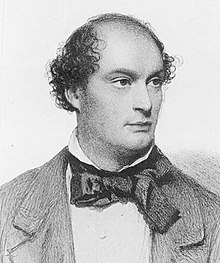Daniel Maclise
| Daniel Maclise | |
|---|---|

1857 lithograph of Daniel Maclise
by Charles Baugniet |
|
| Born |
25 January 1806 Cork, Ireland |
| Died | 25 April 1870 (aged 64) Chelsea, England |
| Nationality | Irish |
| Known for | History painting; Portrait painting |
Daniel Maclise RA (25 January 1806 – 25 April 1870) was an Irish history, literary and portrait painter, and illustrator, who worked for most of his life in London, England.
Maclise was born in Cork, Ireland, the son of Alexander McLish (also known as McLeish, McLish, McClisse or McLise), a tanner or shoemaker, but formerly a Scottish Highlander soldier. His education was of the plainest kind, but he was eager for culture, fond of reading, and anxious to become an artist. His father, however, placed him in employment, in 1820, in Newenham's Bank, where he remained for two years, before leaving to study at the Cork School of Art. In 1825 it happened that Sir Walter Scott was travelling in Ireland, and young Maclise, having seen him in a bookseller's shop, made a surreptitious sketch of the great man, which he afterwards lithographed. It became very popular, and led to many commissions for portraits, which he executed, in pencil.
Various influential friends recognised Maclise's genius and promise, and were anxious to furnish him with the means of studying in London; but refusing all financial assistance, he saved the money himself and arrived in the capital on 18 July 1827. There he made a sketch of Charles John Kean, the actor, which, like his portrait of Scott, was lithographed and published, making the artist a considerable sum. He entered the Royal Academy schools in 1828, eventually being awarded the highest prizes open to students.
Maclise exhibited for the first time at the Royal Academy in 1829. Gradually he began to confine himself more exclusively to subject and historical pictures, varied occasionally by portraits – such as those of Lord Campbell, novelist Letitia Landon, Dickens, and other of his literary friends. In 1833, he exhibited two pictures which greatly increased his reputation, and in 1835 the Chivalric Vow of the Ladies and the Peacock procured his election as associate of the Academy, of which he became full member in 1840. The years that followed were occupied with a long series of figure pictures, deriving their subjects from history and tradition and from the works of Shakespeare, Goldsmith and Le Sage.
...
Wikipedia
